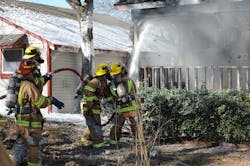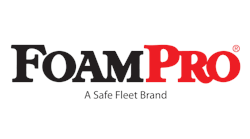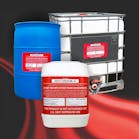Choosing a Foam System Requires Examining Hazards
Since 1877, when foam was first introduced as a fire suppression agent, it has been part of the firefighters’ arsenal. Over 100 years later, in the 1980s, foam was popularized as an effective wildland firefighting agent and its popularity has grown since.
Today, foam has become commonplace as many fire departments have installed or are contemplating installation of foam systems. No longer is it one of those flash-in-the-pan, wiz-bang items that seem to crop up in the fire service every once in a while. It’s becoming more widely accepted as a way to make water more effective and to go further in suppression efforts.
Experts say that fire departments thinking about purchasing foam systems need to think about the kinds of calls they have, the number of incidents and the kinds of fire flows needed to get the job done before selecting the right system for their departments.
Firehouse talked to three manufacturers to get the latest innovations on foam technology and tips to help firefighters make the right decisions when it comes to specifying foam on their apparatus. Those adding their voices to the conversation are Trident Emergency Products, Hatboro, PA; W. S. Darley & Co., Itasca, IL, and Hale Products, Ocala, FL.
Safe Fleet/FoamPro
Michael Dupay is division vice president of marketing for Safe Fleet, the parent company of FoamPro. He has decades of experience with foam systems and the fire service.
Dupay said there are three basic kinds of foam systems: automatic direct inject systems, around the pump systems and balanced pressure systems. Each one has pros and cons for particular applications but each will meet or exceed the standards set forth by the National Fire Protection Association (NFPA) for foam applications.
The first step for departments considering foam system is to identify the need and the risk, Dupay said.
“You have to determine what are your hazards,” Dupay said, adding that applications may include everything from structure fires to bomb threats and bio and chemical hazmat situations. The departments will have to determine what their most likely, and biggest threats when selecting foam systems, Dupay said.
When departments determine the hazards, they will then need to determine how much time they might need to flow foam at the incidents.
“You have to look what your worst case scenario is and determine the critical application,” Dupay said, adding that departments will also need to determine if Class A or Class B foam is the more appropriate agent.
Dupay said he believes there’s a lot of misunderstandings about what foam is and which one departments should use.
“A lot of people don’t understand the basic foam classifications,” he said. “Class A foam is a surfactant that reduces the surface tension of water and allows the water to penetrate rather than bead up and run off.”
As an illustration, Dupay said when washing a car, plain water will bead up and roll of the car. Adding soap to the water will allow it to spread over the vehicle and stick a little better.
“That untreated water is what we see beading up and flowing out the front door at a house fire,” Dupay said.
Class B foam, on the other hand, creates a film, typically over hydrocarbons, like gasoline and petroleum-based fuels or polar solvents and alcohol-based agents.
“The kinds of incidents departments respond to will dictate what kind of foam you’re supposed to use,” Dupay said.
As a general rule, the flow rates for Class A foam are much lower than that for Class B, Dupay said. He explained that for Class A foam systems, 0.5 percent is a good amount for fire attacks, while a full 1 percent for exposure protection is a good number and 0.3 percent is used for mop-up operations.
Class B foam flow rates are generally much higher at a 1, 3 and 6 percent depending on the application, Dupay said. And at a large petrochemical or tank fire, it’s not unusual to flow as many as 200 to 300 gallons of foam concentrate a minute.
Dupay said departments should also consider the accuracy of the foam system, considering Class B foam cost about $40 per gallon.
Lower cost foam systems can be less accurate at proportioning foam and water, he said, noting that while it might be effective at fighting fire, using more foam than necessary can be unnecessarily expensive and increase logistical requirement.
Around the pump foam systems, where foam is introduced into the pump and available to all discharges is low cost for initial purchase and are typically less accurate than direct injection systems, Dupay said. Direct injection systems meter exact amounts of foam into specified discharge lines and adjust the amount of foam used based on the amount of water flowing in specific lines, he said.
FoamPro also offers multi-point injection systems where each discharge has a separate control head that meters foam, but uses the same injection pump commonly used on industrial apparatus, Dupay said.
Dupay said direct injection foam systems are “extremely accurate,” delivering foam with a 95 percent accuracy rate.
Beyond initial costs, Dupay said departments should consider the cost of use and maintenance. Low cost systems will do the job, but may cost more to operate because of the wasted foam it will consume.
“Overall, on-going costs should be considered,” Dupay said.
He added that he and a colleague helped write a “buyers’ guide” for the Fire Apparatus Manufacturers Association (FAMA) that helps fire departments select the proper foam systems for their particular needs.
Waterous
Gregg Geske is the director of North America sales for Waterous, a maker of pumps, foam systems and compressed air foam systems (CAFS). He also serves on the foam maintenance committee for FAMA.
As an expert in the field, Geske said one of the most important things fire departments can do as they work on foam specifications is to communicate with their builders.
Manufacturers will need to know before any rig construction begins whether the department wants Class A or Class B foam systems, or if they want compressed air foam systems, Geske said.
Additionally, the manufacturer will have to know how many discharges will have foam capabilities and what kind of system, around the pump, injection systems and whether the department wants it to engage automatically when the water pump is engaged.
“Adding Class A foam is twice as effective as just water,” Geske said, adding that foam makes bubbles and increasing the surface area of the suppressing agent which is comprised of water and surfactant.
Geske said departments will need to determine what kind of flow rates they’ll need to provide the best service to their communities. Some communities might have big petroleum tank farms or busy highways with a variety of materials being trucked over the roads.
By far, Geske said the biggest decision departments will have to make is whether they want Class A or Class B foam systems. Communities with the big tank farms will need massive Class B systems to keep up with the prescribed flow rates.
In the 32 years of firefighting, responded to tens of thousands of calls, Geske said he has responded to just two truly Class B foam fires.
The cost of foam systems can range from about $5,000 for a system that will flow about 1.5 gallons per minute which is adequate for most structure fires up to $20,000 for systems that will flow 15 gallons per minute for large Class B applications.
Compressed air foam systems are more costly than simple Class A and B foam system and Geske said between 6 and 8 percent of the apparatus built annually have CAFS available.
That compares to almost 60 percent of apparatus built with foam systems, without compressors dispensing just Class A or B foam without the air component, Geske said.
Geske, who helped author the FAMA resource paper on foam with Dupay, agrees that it is a valuable tool to help fire departments determine what is best for their particular application.
Trident Emergency Products
Steve Tolbert, the foam products manager for Trident Emergency Products, said departments need to consider their response area and the hazards they may encounter when considering the type and size of the foam system they might need.
“From my perspective, obviously a lot of municipal trucks are putting Class A systems on,” Tolbert said. “They are pretty common today.”
Tolbert said departments need to consider the number of hoselines they might want to have foam capable when specifying a truck. If departments want the crosslays, or speedlays, and perhaps a couple of discharges, that could be handled by a smaller system.
“You should look at your worst-case scenario and back in from there,” Tolbert said. “You should look at the size of your department, how many calls you make, what kinds of situations you’ll get into, and your expected fire flow. There are some situations where no one department can handle it.”
Part of the discussion about what kind of system a department needs will, undoubtedly, focus on the kinds of fire to which a department might be expected to respond. Class B foam systems are meant primarily for fuel, plastics and chemical fires with industrial applications while Class A foam is used for just about everything else, including structure and wildland fires.
“There are some built with Class A and Class B capabilities,” Tolbert said, noting that there are cases where that can be beneficial. “The likelihood of using both at the same time are rare,” he said, adding that it’s probably a good idea for departments to choose one or the other to be most effective.
Tolbert said there are a few of different foam delivery systems as well. One is a balance pressure system that has been around 60 to 70 years, he said, noting that water pressure squeezes a bladder to allow foam to enter in in water stream flow.
Another system is the direct injection that uses a flow meter to control a variable speed foam pump that moves the foam at a predictable rate, which is injected into the discharge lines, Tolbert said. The changing speed of the pump dictates the amount of foam that enters each line for more control.
There are also around-the-pump delivery systems whereby foam is pumped into the apparatus’ water pump and available for all discharges. And yet another system uses a venturi to pull foam into the fire flow.
Tolbert said Trident has been in business since 2001 and has been producing positive displacement foam pumps for a variety of foam system makers over the years. It also has its own proprietary rotary-gear positive-displacement pump used for industrial applications.
Those pumps can deliver from 30 to 500 gallons per minute of foam for very large fires, Tolbert said. For comparison, most fire apparatus have foam cells of between 20 and 30 gallons total, which is metered out at ratios of .3 up to 3 percent.
W.S. Darley & Co.
For W.S. Darley & Co., the best way to deliver foam to a fire is through compressed air, said Troy Carothers, Darley AutoCAFS manager. CAFS is the addition of compressed air to the water and foam solution.
“Foam improves the wetting ability of water,” Carothers said. “We need this because so much of what we use to build structures of today are stain resistant and, therefore, water resistant.”
Carothers added that compressed air makes the typical Class A foam system much more effective than straight water, or even with foam in it.
“Bubbles are way more efficient at absorbing heat than droplets of water,” Carothers said. He explained that only the surface of the area of a water droplet has any effect on a fire, leaving the rest of the water droplet to run off and be wasted, or worse, causing water damage to the structure.
“Droplets, no matter what the size, are balls of cool water and only the surface makes contact with the fire,” Carothers said. “Often, much of it never comes in contact with the fire. Much of it hits the walls and hits other surfaces and that’s why we have water damage.”
Carothers says that at the rate of 10 percent efficacy, a discharge rate of 150 gpm means only 15 gallon are doing the job.
“We’ve chosen to use compressed air to propel it,” Carothers said. By using pneumatics with soap and water to create bubbles means far less wasted water. He said flow rates of 50 to 70 gpm make some nice bubbles with some reaching with 50 to 60 percent heat absorption rate.
Carothers said he believes that the use of Class A foam is a cancer-reducing agent as the foam bonds to carbon. Therefore sending compressed air foam through smoke could reduce firefighter cancer exposure risks, Carothers said. “Using plain water is just pushing carbon around.”
And, Carothers said, lessening the time it takes to extinguish a fire lessen the time firefighters are exposed to carcinogens.
“Lessen the risk, lessen the exposure,” Carothers said.
Carothers said Class A foam and CAFS can also offer labor savings by “doing something quicker with less people.” That could be an advantage for fire departments that are short staffed, he said.
And speaking of doing more with less, Carothers said Darley introduced a Ford F-550 Quick Attack apparatus with CAFS at a recent trade show. The apparatus is built for a segment of fire departments that need small and maneuverable apparatus, but with big fire knockdown power.
That’s why Darley’s new quick attack unit has a 1,500-gpm pump, a FoamPro 2001 foam system and a 120-cfm compressor for CAFS for up to four discharges.
“It can handle everything from a med call to a full-blown structure fire,” Carothers said, adding that unlike bigger pumpers, the attack unit can run up a mountain driveway or down a narrow, lakeside road.
“It’s the best of both worlds,” Carothers said. “It’s small, maneuverable with low-cost maintenance with parts readily available at NAPA or O’Reilly parts stores.
“The cost of ownership is very attractive to some departments,” Carothers said, adding prices for the Darley Quick Attack runs between $250,000 and $300,000, far less than a full-size Class A apparatus.
Hale Products
Jeremy Foxx, product manager for Hale Products also believes the first thing fire departments need to do when specifying foam systems is to determine flow rates and what kinds of fires they will be fighting.
“Then, you have to pick a price point you can afford,” Foxx said. “Most foam systems don’t add much to the overall price of the truck.
There are two basic kinds of foam systems, around-the-pump and direct injection.
Foxx said an around-the-pump system, which places foam directly into the fire pump volute, can lead to more wear on the fire water pump, require more flushing and might pollute a water source when drafting.
A direct inject system puts foam in certain discharges and is more accurate at foam delivery, reducing foam waste, Foxx said.
“If you are looking for a more accurate system, go for the direct injection system,” Foxx said. “With direct injection, you can target a [range] of foam rate. You don’t want to waste foam.”
If a department selects direct injection, it should then “focus on the technology” of the system they want.
Hale has a system that is “extremely users friendly and takes the guess work out of it,” Foxx said.
“We have plain text warnings, tutorials and pre-sets built in,” Foxx said. “It’s been really helpful for the departments that don’t know the flow rate. If you have a car fire, you can hit the pre-set for a car fire, or mop-up. You can increase or decrease the foam flow rate as needed. We are trying to reduce the number of steps because there’s already a lot going on at a fire scene.”
Information is displayed on a LCD screen that Hale calls UltraView, Foxx said, noting that the screen is flanked by push button controllers and some features are available by touching the screen for operations.
Users can see water and foam use on the screen as well as the speed of the foam injection pump and it is visible in bright sun, Foxx said of the 4.5-inch screen.
“It’s easy to see, a nice size, and you can see it from far away,” Foxx said of the proprietary product.
The controller is made by a Hale sister company Class 1 and is programmed by Hale to work with its foam systems, Foxx said.
Foam systems need to be maintained to keep them functioning properly for the life of the product, Foxx said. That’s why Hale’s controller gives the user feedback, like a log of use time, an indication of what needs to be serviced and, if necessary, how to get the part. That information is all revealed on the screen, he said.
Hale’s foam controller also has a safety feature built in that allows foam to continue to flow even if something happens to the system, like a sensor failing. A light, similar to a check engine light on a vehicle, will illuminate, but the foam system will continue to operate in a “limp mode,” allowing the system to be used. The accuracy of the foam injection might decrease, but foam will still be flowing, he said.
Like other manufacturers, Hale has its own CAFS system, which uses the same UltraView controller screen, but bigger at 7 inches, Foxx said.
The SmartCAFS by Hale features a total pressure governor and easy to use pre-set operation buttons for a variety of fire scenarios, including structure fires.
“It’s really easy and fast to use,” Foxx said. “You just throw the pump into gear, put the truck’s transmission in to fourth-gear lock up, open the tank to pump valve, push the SmartCAFS button and it activates the compressor and sets the foam concentrate. Then you go and put the fire out. It works very well.”
Foxx said departments also should not overlook how they’ll refill the foam cell on the apparatus. In many cases, refilling requires firefighters to climb up to the top of the apparatus to manually pour foam into the cell integrated in the water tank. Foxx said it’s not an efficient way to refill the foam cell and puts firefighters at risk for slip and fall injuries because the apparatus are big, often wet and slippery from water flow and weather conditions.
That’s why Hale has an EZ-Fill foam pump dedicated to refilling the foam systems, Foxx said, noting the 5.5-gpm refill pump can put five gallons in a foam cell in less than a minute. A firefighter with a 5-gallon pail of foam takes 4.5 minutes for the same procedure.
Foxx said departments that specify the EZ-Fill system should make room for foam pails low on the apparatus, in the compartments perhaps, or the automated refilling system is moot. It doesn’t make sense for a firefighter to climb to the dunnage area above the pump and lift down the pail to have the refill pump push it back up to the cell.










